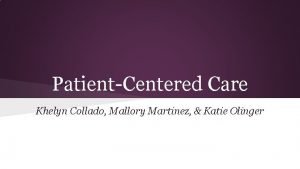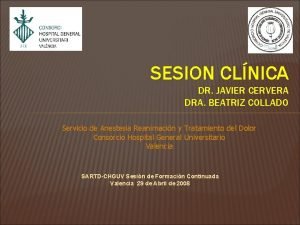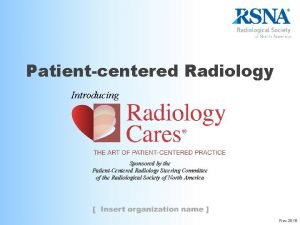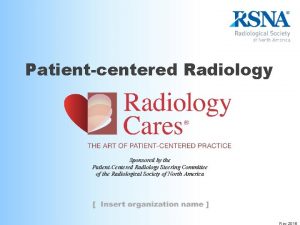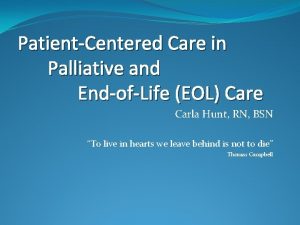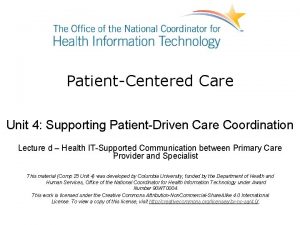PatientCentered Care Khelyn Collado Mallory Martinez Katie Olinger
























- Slides: 24

Patient-Centered Care Khelyn Collado, Mallory Martinez, & Katie Olinger

Patient-Centered Care (PCC) “Recognize the patient or designee as the source of control and full partner in providing compassionate and coordinated care based on respect for patient’s preferences, values, and needs. ”- QSEN(5)

Individualized Care “Individualization of care means considering each patient separately, (i) taking patient’s clinical characteristics and situation and (ii) personal life situation into account, and (iii) enabling decisional control over patient’s own care. ”(4) In today’s society, we cannot use the “one size fits all approach”! (1)

Why is Individualized Care Important? 1. Knowing the patient as central to skilled judgement. ● By knowing the patient, nurses can make judgments about the patient’s behavior and clinical condition which enables them to choose an appropriate intervention. (8) 1. Involvement ● Enhanced communication between the nurse and the patient allows the nurse to gage how much interaction is needed for that patient. (8)

Why is Individualized Care Important? 3. ) Advocacy: ● Nurses who have a deep understanding of the patient and his. her needs, can stand up as advocates to make sure that the patient is getting the best medical care. (8) 4. ) Knowing the patient as part of clinical learning: ● Knowing your patient will allow nurses to become more culturally competent. (8) C important?

What is the problem? Due to hospital structure, standardized protocols, time restrictions, and high patient-nurse ratios, patient’s psychosocial needs are not being met. (1, 4, 7, 8)


Influencing Factors Enhance ● The length of a nurse’s clinical experience (7) ● Keeping patient’s desired outcomes in mind (8) ● Effective communication skills ● Self-presentation ● Showing concern Detract ● Structure of the organization (7) ● Unclear perception of PCC by the nurses (7) o N 0 t seen as a task to be completed (4) ● High patient-nurse ratio (7)

How can we fix this? 1. Education on Individualized Patient Care 2. TIM Board 3. 3 -day symposium for CEUs

Individualized Care Courses & Symposium Individualized Care Hours for Nurses ● Why change is needed ● Significance of change ● How to implement individualized care as a nurse Hospital-Wide Symposium for CEUs ● A symposium will be held a year after implementation to evaluate progress of the intervention, and to share knowledge and experiences among hospital units.

Patient Care Boards

Activity Time

This is Me! (TIM) Board

It’s more than just a board!

Timeline for Proposed Changes

Finances Budget: $50, 000 Expenses are based on 190 bed hospital and a patient-nurse ratio of 1: 4 -TIM Board → $16, 867 - Customized 2 x 2 whiteboard: $87 each - Dry-erase markers: $1 each - Dry-erasers: $1. 77 each - Competency for patient centered care → $4, 704 - 1 hour online course in the hospital (repeated annually) - 96 nurses x $49 (Overtime pay) - Symposium for 3 days → $18, 000 - $6, 000/day - Marketing → $1, 000 - $1, 000 for hospital-wide marketing - Raffle Prizes → $600 - $50/ month Grand Total: $41, 171

Marketing - Posters reminding nurses to use the TIM Board - Mouse pad - “Did you learn something about your patient today? ” - Add questions to the patient-satisfaction survey. - “Did your nurse explain the purpose of the TIM board? ”


Kurt Lewin: Change Theory

Stages of Change Stage 1 - Unfreezing -Patient Satisfaction, HCAHPS Data, & Literature Stage 2 - Movement -Plan: Education, TIM Board -Goal: >90 % on Nursing Communication (HCAHPS) -December 2015 end of implementation -Begin Marketing and Support -Evaluate if goal has been met Stage 3 - Refreezing -Symposium: Continuous yearly support

Evaluation Tool “Patient Care Card” (PCC) ● A patient can fill out a PCC if they want to acknowledge their nurse for doing a great job. ● All of these cards will be put into a raffle at the end of the month for a chance to win a gift certificate with a $50 value. ● The PCC can be used to measure shortterm outcomes in regards to patient satisfaction of care.

Evaluation Tool (HCAHP)

Summary ● After implementing the TIM Board, online course, and symposium, we reached 94 th percentile on our HCAHP report for Nursing Communication. ● During the implementation process, we encountered problems with compliance. o In order to address this compliance issue, we would include the utilization of the TIM Board during handoff reports.

References 1. Ghebrehiwet, T. (2011). Nurses and person-centered care. The International Journal of Person Centered Medicine, 1(1), 20 -22. 2. HCAHPS: Communication with nurses. (2015, April 16). Retrieved from June 3, 2015, from http: //www. hcahpsonline. org/Files/Report_April_2015_Chart. Book. pdf 3. Marquis, B. & Huston, C. (2009). Leadership roles and management functions in nursing: Theory and application (8 th ed. ). Philadelphia: Wolters Kluwer Health/Lippincott Williams & Wilkins. 4. Papastavrou, E. , Acaroglu, R. , Sendir, M. , Berg, A. , Efstathiou, G. , Idvall, E. , & Suhonen, R. (2015). The relationship between individualized care and the practice environment: An international study. International Journal of Nursing Studies, 52, 121 -133. doi: 10. 1016/j. ijnurstu. 2014. 05. 008 5. Patient-centered care. Retrieved June 3, 2015, from http: //qsen. org/competencies/patient-centered-care-resources 6. Patient room board. Retrieved June 3, 2015, from https: //www. magneticconcepts. com/patient_room. htm 7. Suhonen, R. , Gustafsson, M. J. , Katajisto, J. , Valimaki, M. , & Leino-Kilpi, H. (2010). Nurse’s perceptions of individualized care. Journal of Advanced Nursing, 66 (5), 1033 -1046. doi: 10. 1111/j. 1365 -2648. 2009. 0526. x 8. Zolnierek, C. (2014). An integrative review of knowing the patient. Journal of Nursing Scholarship, 46(1), 3 -10, doi: 10. 1111/jnu. 12049
 Mallory martinez
Mallory martinez Javier cervera dentiste
Javier cervera dentiste Dr. javier collado
Dr. javier collado Kevin collado
Kevin collado Lvcp rachis
Lvcp rachis Brockels chocolates
Brockels chocolates Mallory bales
Mallory bales Patologia ficatului
Patologia ficatului Jill mallory
Jill mallory Ptah 염색
Ptah 염색 Mallory lynch
Mallory lynch Desplazador de platina del microscopio
Desplazador de platina del microscopio Mallory jeopardy
Mallory jeopardy Fel moodle
Fel moodle Mallory wiess tear
Mallory wiess tear Mallory weiss tear
Mallory weiss tear Mallory body histology
Mallory body histology Primary secondary tertiary medical care
Primary secondary tertiary medical care Carly lockwood
Carly lockwood David kieda
David kieda Katie simandl
Katie simandl Katie waldeck
Katie waldeck Katie levitt
Katie levitt Katie's trunk by ann turner
Katie's trunk by ann turner Katie fazio
Katie fazio
